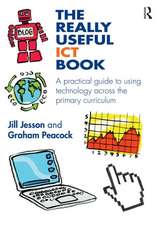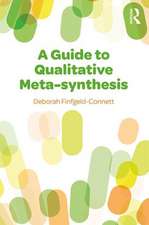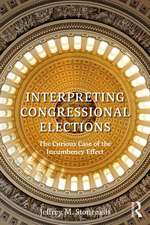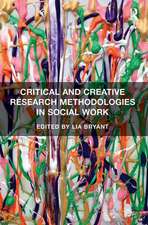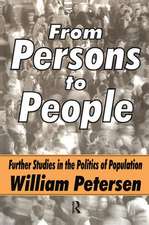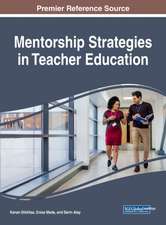Doing Your Literature Review: Traditional and Systematic Techniques
Autor Jill Jesson, Lydia Matheson, Fiona M Laceyen Limba Engleză Paperback – 27 feb 2011
Contents include:
- using libraries and the internet
- note making
- presentation
- critical analysis
- referencing, plagiarism and copyright.
Jill K. Jesson has worked with multi-disciplinary research teams within the Aston School of Pharmacy, Aston Business School and with M-E-L Research, an independent public services research consultancy. She has now left Aston University and is working as a Consultant.
Lydia Matheson is an Information Specialist working for Library & Information Services at Aston University.
Fiona M. Lacey is an academic pharmacist, a member of the pharmacy practice teaching group in the School of Pharmacy, and Associate Dean in the School of Life and Health Sciences at Aston.
| Toate formatele și edițiile | Preț | Express |
|---|---|---|
| Paperback (1) | 276.09 lei 3-5 săpt. | +14.53 lei 4-10 zile |
| SAGE Publications – 27 feb 2011 | 276.09 lei 3-5 săpt. | +14.53 lei 4-10 zile |
| Hardback (1) | 875.83 lei 6-8 săpt. | |
| SAGE Publications – 10 feb 2011 | 875.83 lei 6-8 săpt. |
Preț: 276.09 lei
Nou
Puncte Express: 414
Preț estimativ în valută:
52.83€ • 55.31$ • 43.71£
52.83€ • 55.31$ • 43.71£
Carte disponibilă
Livrare economică 17-31 martie
Livrare express 28 februarie-06 martie pentru 24.52 lei
Preluare comenzi: 021 569.72.76
Specificații
ISBN-13: 9781848601543
ISBN-10: 1848601549
Pagini: 192
Ilustrații: black & white tables, figures
Dimensiuni: 170 x 242 x 10 mm
Greutate: 0.33 kg
Ediția:First Edition
Editura: SAGE Publications
Colecția Sage Publications Ltd
Locul publicării:London, United Kingdom
ISBN-10: 1848601549
Pagini: 192
Ilustrații: black & white tables, figures
Dimensiuni: 170 x 242 x 10 mm
Greutate: 0.33 kg
Ediția:First Edition
Editura: SAGE Publications
Colecția Sage Publications Ltd
Locul publicării:London, United Kingdom
Recenzii
'Tasks, tips, examples, figures and summaries in each chapter give the book a "self-guided" feel appropriate in a textbook, and the language is rarely arcane. Four useful appendices and a fine index complete the work. Overall, this is a sound guide for the absolute neophyte in how to create useable literature reviews. Part 2 is especially recommended as a good discussion of the ways and means of writing reviews. The work is useful for students at most levels, and for those who teach research methods and want a clear guide for literature reviews for their reading lists' -
G. E. Gorman
Online Information Review
'The main strength lies in the book's practical nature. The authors place great emphasis on the importance of proper searching techniques and encourage the use of specialist librarians. Chapters on reading and note-taking skills contain useful detail often missing from similar books - such as which bits of an article to read first, and how to make and store relevant notes that will be usable later. The examples of how to improve specific passages of writing are very valuable.'
The book does what it promises: it is an accessible and practical book, which many researchers can benefit from to improve their literature reviews.
G. E. Gorman
Online Information Review
'The main strength lies in the book's practical nature. The authors place great emphasis on the importance of proper searching techniques and encourage the use of specialist librarians. Chapters on reading and note-taking skills contain useful detail often missing from similar books - such as which bits of an article to read first, and how to make and store relevant notes that will be usable later. The examples of how to improve specific passages of writing are very valuable.'
The book does what it promises: it is an accessible and practical book, which many researchers can benefit from to improve their literature reviews.
Cuprins
Introduction
Who is this book for?
How is this book different?
The rationale and history behind the contributions from a researcher and from an information specialist
Features of the book
Layout of the book
PART ONE: GETTING INFORMATION
Preliminaries
What is a literature review?
Terminology used in this book
Different styles of review
Two styles or approaches
A critical approach
Knowledge and literature
Why and when will you need to review the literature?
The research question and the literature review
What is appropriate literature?
Choosing which style of review: a traditional narrative review or a systematic review
Project management
Searching for Information
Introduction
Develop online searches by identifying key words and creating a search record
The range of information sources available for complex searches.
What do you need from a resource to make it appropriate for locating journal articles for your review?
Reading Skills
Introduction
Be analytical in your reading
Where to start
Reading techniques - scan, skim and understand
Reading different types of material
Grey literature: non academic sources and policy reports
Recording and note making
From Making Notes to Writing
Introduction
Note-making
From notes to writing
Writing - critical writing and types of argument
Making a value judgment and bias
PART TWO: USING INFORMATION
The Traditional Review
Overview of the debate
Types of review: critical, conceptual state of the art, expert and scoping
Draw up an analytical framework - how to sort the material
Moving to analysis and synthesis
The presentation of your review
Summarizing the gap - dare to have an opinion.
Writing up Your Review
Overview
A short summary
A self-standing review
Abstract, executive summary and annotated bibliography
Writing the review
Key words or phrases to help you move from stage 1 to stage 2
The 'so what' question, originality and making a value judgment
The Systematic Review
Overview
Definitions
Development of the review protocol
Formulating the review question
Documenting your progress
Locating studies and sources of information
Selecting studies: inclusion and exclusion criteria
Appraisal - assessing the quality of research
Data extraction
Synthesis, drawing conclusions, what the review shows
Evolving formats of systematic review
Meta- Analysis
Overview
What is meta-analysis?
Can I use meta-analysis to summarise the results of my systematic review?
Undertaking your meta-analysis
Displaying the results of a meta-analysis
Is your meta-analysis free from bias?
Performing a sensitivity analysis
Referencing and Plagiarism
Introduction
Why is referencing important?
What do you need to reference?
How many references should I provide?
When and how to reference
Referencing systems
Where to find citation information you need
Plagiarism
Copyright
Conclusion
Summary
Appendices
Appendix 1: Further reading
Appendix 2: Critical review checklist
Appendix 3: Systematic review online resources
Appendix 4: Resources for meta-analysis
Glossary
Who is this book for?
How is this book different?
The rationale and history behind the contributions from a researcher and from an information specialist
Features of the book
Layout of the book
PART ONE: GETTING INFORMATION
Preliminaries
What is a literature review?
Terminology used in this book
Different styles of review
Two styles or approaches
A critical approach
Knowledge and literature
Why and when will you need to review the literature?
The research question and the literature review
What is appropriate literature?
Choosing which style of review: a traditional narrative review or a systematic review
Project management
Searching for Information
Introduction
Develop online searches by identifying key words and creating a search record
The range of information sources available for complex searches.
What do you need from a resource to make it appropriate for locating journal articles for your review?
Reading Skills
Introduction
Be analytical in your reading
Where to start
Reading techniques - scan, skim and understand
Reading different types of material
Grey literature: non academic sources and policy reports
Recording and note making
From Making Notes to Writing
Introduction
Note-making
From notes to writing
Writing - critical writing and types of argument
Making a value judgment and bias
PART TWO: USING INFORMATION
The Traditional Review
Overview of the debate
Types of review: critical, conceptual state of the art, expert and scoping
Draw up an analytical framework - how to sort the material
Moving to analysis and synthesis
The presentation of your review
Summarizing the gap - dare to have an opinion.
Writing up Your Review
Overview
A short summary
A self-standing review
Abstract, executive summary and annotated bibliography
Writing the review
Key words or phrases to help you move from stage 1 to stage 2
The 'so what' question, originality and making a value judgment
The Systematic Review
Overview
Definitions
Development of the review protocol
Formulating the review question
Documenting your progress
Locating studies and sources of information
Selecting studies: inclusion and exclusion criteria
Appraisal - assessing the quality of research
Data extraction
Synthesis, drawing conclusions, what the review shows
Evolving formats of systematic review
Meta- Analysis
Overview
What is meta-analysis?
Can I use meta-analysis to summarise the results of my systematic review?
Undertaking your meta-analysis
Displaying the results of a meta-analysis
Is your meta-analysis free from bias?
Performing a sensitivity analysis
Referencing and Plagiarism
Introduction
Why is referencing important?
What do you need to reference?
How many references should I provide?
When and how to reference
Referencing systems
Where to find citation information you need
Plagiarism
Copyright
Conclusion
Summary
Appendices
Appendix 1: Further reading
Appendix 2: Critical review checklist
Appendix 3: Systematic review online resources
Appendix 4: Resources for meta-analysis
Glossary
Notă biografică
Descriere
Guiding students through the process of writing both traditional and systematic literature reviews, this book tackles an area that is an integral part of doing research, yet is often overlooked by other methods texts.

